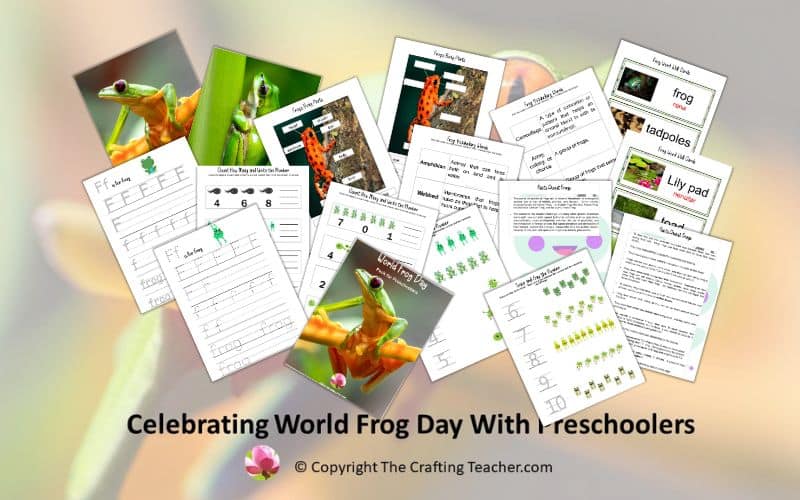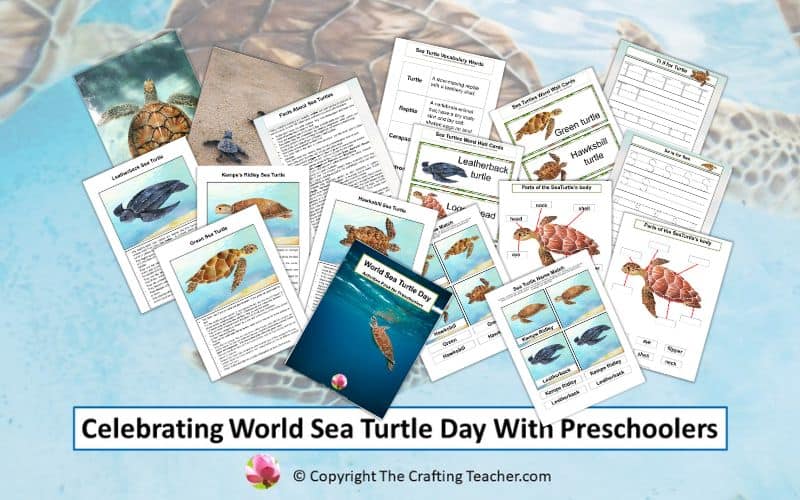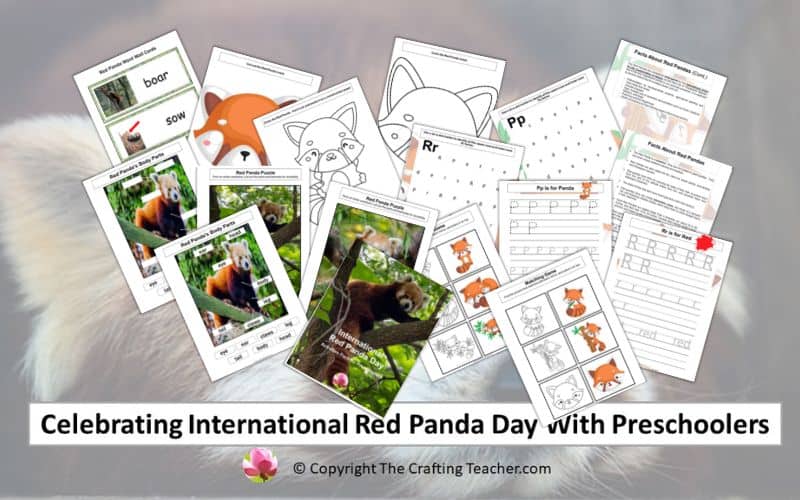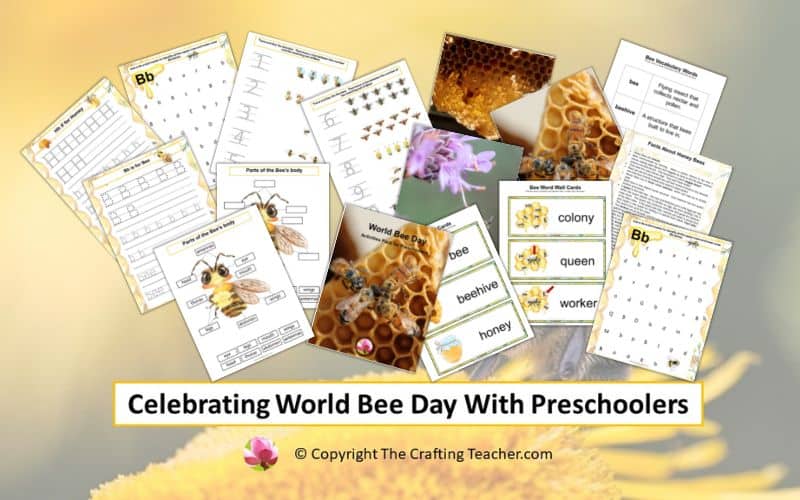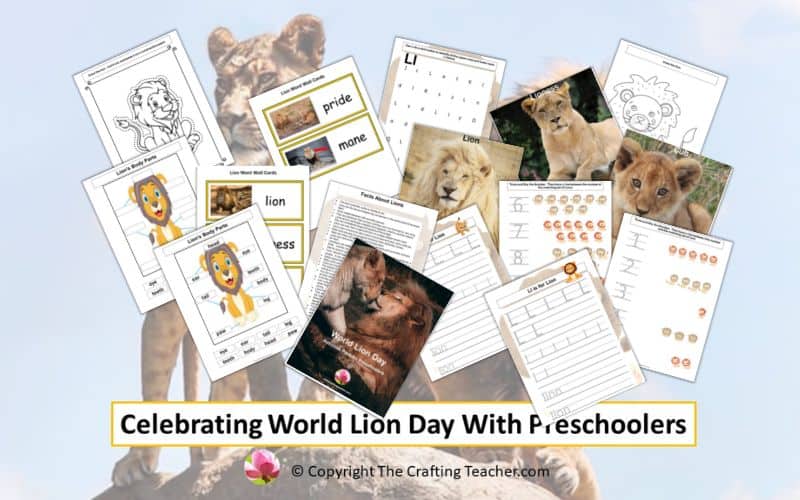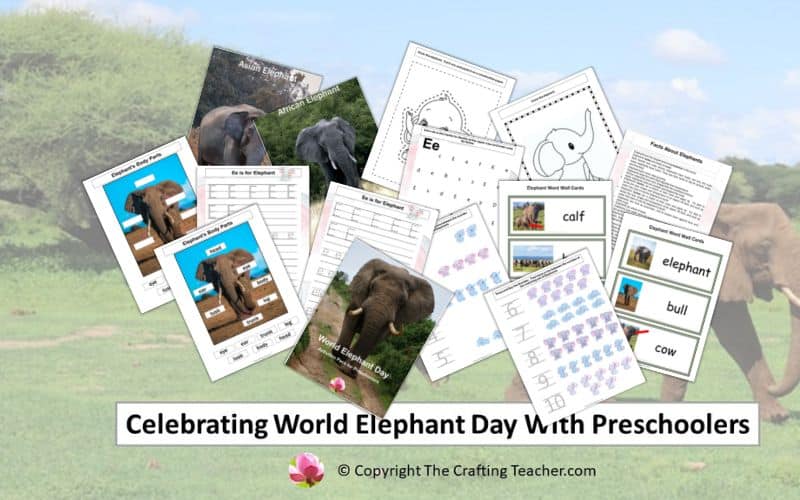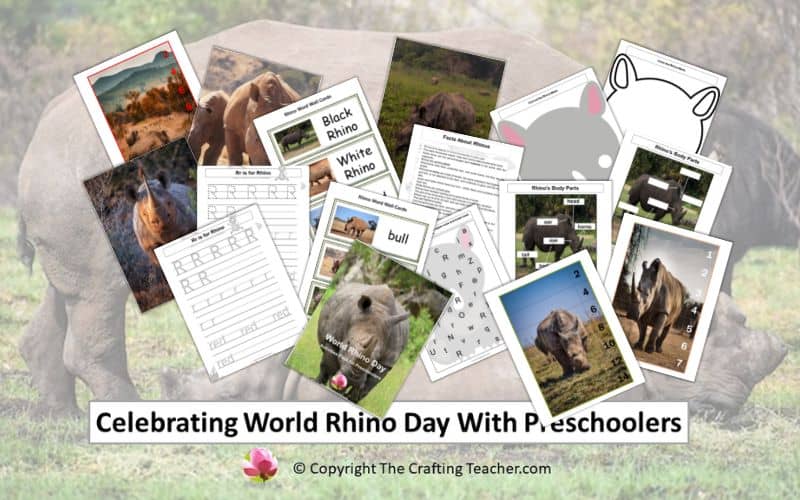Celebrating World Frog Day with Preschoolers
Affiliate Disclosure: “This post contains affiliate links, which means I receive a small commission, at no extra cost to you, if you make a purchase using those links.”
World Frog Day is celebrated worldwide on March 20th, to raise awareness about frogs and other amphibians that are critically endangered, trying to protect them and provide them with safer habitats and avoid their extinction.
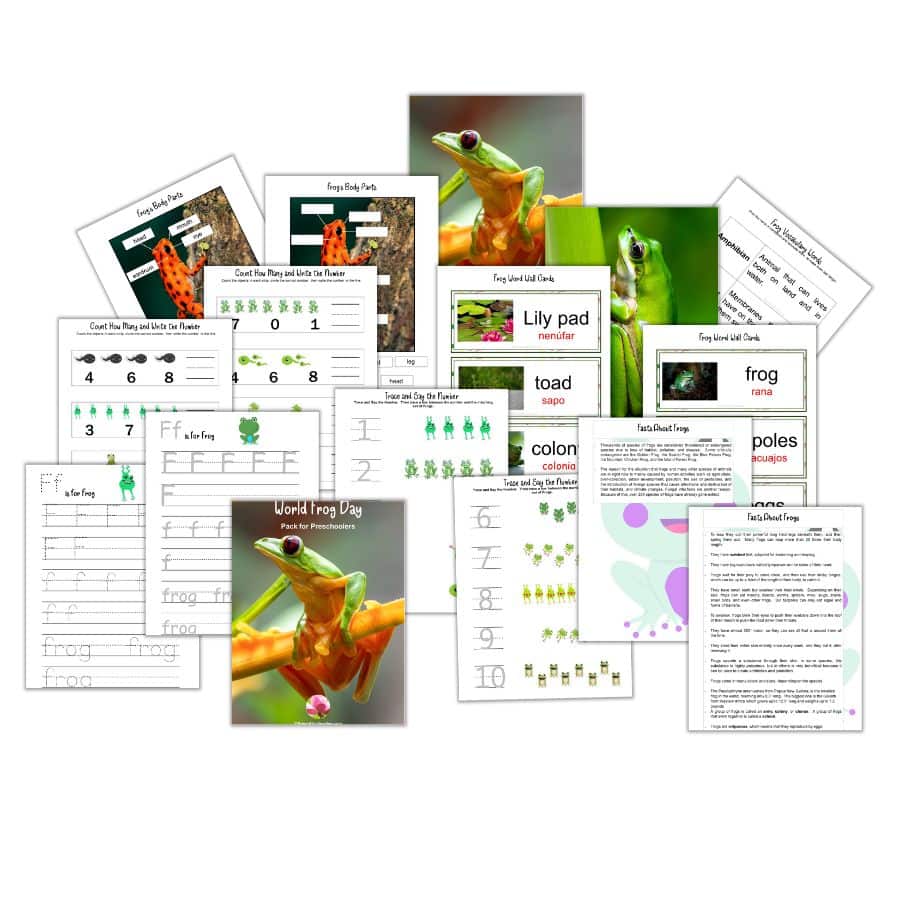
I’ve included a FREE 20–page long World Frog Day Pack, with activities to do with your preschoolers. You can get it at the end of this post.
History of World Frog Day
World Frog Day was first established in 1995 but has been celebrated since 2014. I have not found the information about who or what organization started this celebration.
Frogs are a true indicator of a proper well-balanced and healthy ecosystem, and the fact that we are losing so many species already indicates that something is very wrong. Unfortunately, finding ways to avoid their complete extinction is proving to be one of the most difficult conservation efforts in the history of humanity.
Facts About Frogs
- Frogs have existed on Earth for more than 200 million years.
- They are amphibians, which means “two lives” because their species spend the first part of their life in water and the second part of their life on land.
- The world’s largest frog is the goliath frog of West Africa—it can grow to 15 inches and weigh up to 7 pounds.
- One of the smallest is the Cuban tree toad, which grows to half an inch long.
- While the life spans of frogs in the wild are unknown, frogs in captivity have been known to live more than 20 years.
- Frogs have excellent night vision and are very sensitive to movement. The bulging eyes of most frogs allow them to see in front, to the sides, and partially behind them.
- They don’t have rib cages, and their bodies are mostly soft and flexible, which allows them to squeeze into small spaces and helps them to swim quickly through the water.
- Frogs have vocal cords and can make almost a thousand different sounds, that can be heard from a mile away.
- Frogs don’t drink water. They absorb water directly into their body through their skin.
- They breathe through the nose and their slimy skin.
- They are aquatic animals that need to live near water and stay moist to survive. That’s why you can find frogs mostly near streams, lakes, rainforests, swamps, ponds, creeks, trees and other wet locations.
- Frogs are found on every continent except Antarctica.
- Frogs have smoother, slick skin, narrow bodies, and high, circular bulging eyes.
- To leap they coil their powerful long hind legs beneath them, and then spring them out. Many frogs can leap more than 20 times their body length.
- They have webbed feet, adapted for swimming and leaping.
- They have big round ears called tympanum on the sides of their head.
- Frogs wait for their prey to come close, and then use their sticky tongue, which can be up to a third of the length of their body, to catch it.
- They have small teeth but swallow their food whole. Depending on their size, frogs can eat insects, lizards, worms, spiders, mice, slugs, snails, small birds, and even other frogs. But tadpoles can only eat algae and forms of bacteria.
- To swallow, frogs blink their eyes to push their eyeballs down into the roof of their mouth to push the food down their throats.
- They have almost 360° vision, so they can see all that is around them all the time.
- They shed their entire skin entirely once every week, and they eat it, after removing it.
- Frogs secrete a substance through their skin. In some species, this substance is highly poisonous, but in others is very beneficial because it can be used to create antibiotics and painkillers.
- Frogs come in many colors and sizes, depending on the species.
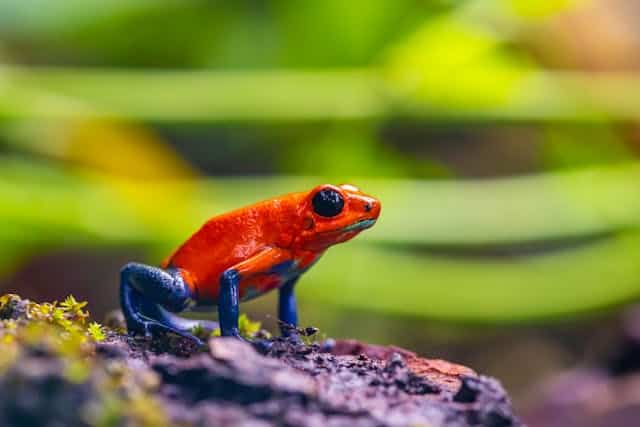
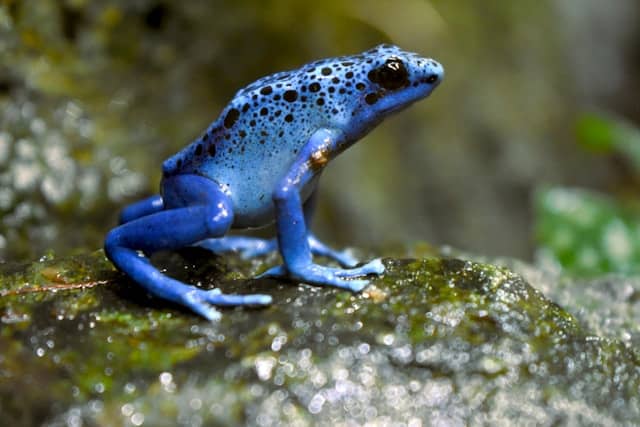
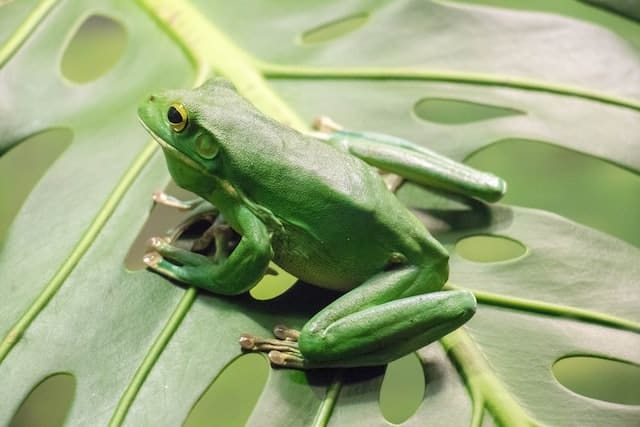
- The Paedophryne amanuensis from Papua New Guinea is the smallest frog in the world, reaching only 0.3” long. The biggest one is the Goliath from Western Africa which grows up to 12.5” long and weighs up to 7.2 pounds.
- A group of frogs is called an army, colony, or chorus. A group of frogs that swim together is called a school.
- Frogs are oviparous, which means that they reproduce by eggs.
- They lay thousands of eggs at once, in eater. A group of eggs is called a frogspawn.
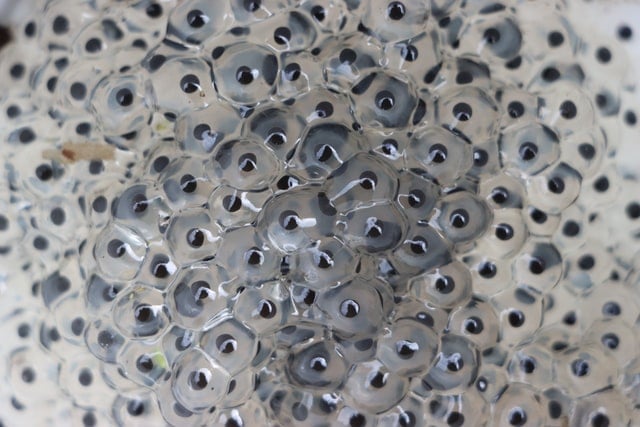
- Frog larvae are called tadpoles, and they hatch looking like fish, with no legs, gills to breathe underwater, and a tail.
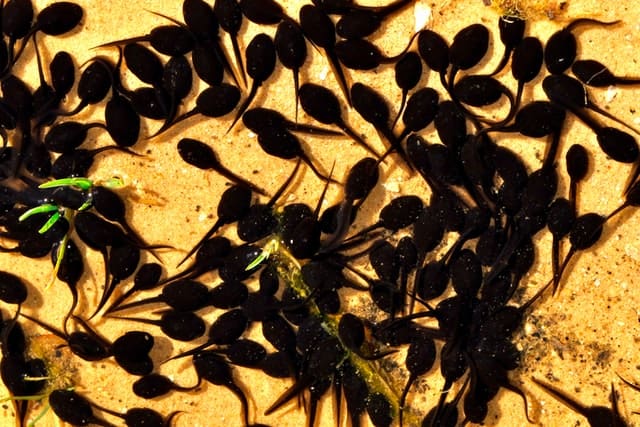
- Over time, they transform into frogs. This process is called metamorphosis in which they grow lungs to breathe air and legs to walk on land. Their tail also disappears.
- Frogs are cold-blooded, and their body temperatures change according to the temperature of their surroundings.
- Frogs hibernate to survive the winter, digging burrows underground or in the mud. Some can even freeze solid, and come back to live in the spring.
- Some frogs can change colors (camouflage) as a protection against predators.
- Frogs develop growth rings on their bones every year, so scientists can then tell how old they are by counting the rings. A scientist who studies frogs is called herpetologist.
- Frogs live 4 to 12 years, depending on the species.
- There are more than 7,000 species of frogs. Some of these species include the African Bullfrog, the Northern Cricket Frog, the Northern Leopard Frog, the Poison Dart Frog, the Red-eyed tree frog, Blue-jeans, Glass, and Tree Frog.
- People eat frog legs in many parts of the world.
- Frogs play an essential role in the ecosystem. They help control harmful insect populations and serve as prey for other animals, such as birds and snakes.
- Thousands of species of frogs are considered threatened or endangered species due to loss of habitat, pollution, and disease. Some critically endangered are the Golden Frog, the Scarlet Frog, the Blue Poison Frog, the Mountain Chicken Frog, and the Island Forest Frog.
- The reason for the situation that frogs and many other species of animals are in right now is mainly caused by human activities such as agriculture, over-collection, urban development, pollution, the use of pesticides, and the introduction of foreign species that cause alterations and destruction of their habitats, and climate changes. Fungal infections are another reason. Because of this, over 200 species of frogs have already gone extinct.
How to Celebrate World Frog Day
- Get to Know Frogs and Raise Awareness. Watch documentaries, read books, and visit websites dedicated to frog conservation. The more you know about the decline in the frog population, the role they play in our ecosystem, how important it is to save them, and what we can do about it, the bigger positive impact you can have in your preschoolers, family, and friends, so they can develop a deeper appreciation for these amazing animals and encourage do what they can for their protection.
- Do Crafts. Preschoolers love to do crafts, and it’s a good way to support your teaching and get them interested. You can find ten easy-to-make ones at artsycraftsymom.com.
- Offer Frog Snacks. Some cute ones are Oreo Frogs from madetobemomma.com, Froggy Crispy Treat from 3littlegreenwoods.com, and Mini Ice Cream Cup Frogs from kidsactivitiesblog.com.
- Use Songs. Music is a universal language, and kids love it. Include songs about frogs in your lesson plans for your preschoolers. One of my favorites is “Five Speckled Frogs”, but you can find many others HERE and HERE.
- Present videos. This is an incredibly useful resource to teach your preschoolers about frogs because they can see details that you cannot teach by just talking or reading. Three very educational videos about frogs are All About Frogs for Kids by FreeSchool, Frogs by Happy Learning English, and The Life Cycle of a Frog: Metamorphosis from Tadpole to Frog for Kids by FreeSchool.
- Organize a Fundraising. Doing this at your school, in your neighborhood, or with your friends and family will probably allow you to collect funds that can be donated to an organization like the Amphibian Ark, which uses 100% of these funds to ensure a long-term future for threatened amphibians. The donated funds are tax-deductible for most US taxpayers.
- Create a Frog Habitat. Make your frog habitat in your backyard, even if is just a small pond. Include native water plants, logs, and rocks, where frogs can find food and hide.
- Plant a Frog Friendly Garden. This could be an amazing activity for your preschoolers as well. Research with types of native shrubs, grasses, and aquatic plants can provide food and shelter for frogs, and create a local garden in your house, your school, and/or your neighborhood. Don’t forget to add a water source like a fountain or a pond.
- Practice and Promote the Three R’s (Reduce, Reuse, and Recycle). Don’t waste water, avoid single-use items, and recycle as much as possible.
- Organize a Cleanup. Organizing a cleanup collecting garbage, removing invasive species, planting native plants, and removing invasive species from wetlands, ponds, rivers, lakes, and forests, will help improve the environment for frogs.
- Practice and Promote Eco-friendly Habits. Small changes in our habits can make a drastic positive impact. Reducing pollution and the use of chemical pesticides, weed killers and fertilizers is a good start.
- Organize a field trip to Observe Frogs. You can visit your local zoo, aquarium, or even a pond and go frog-watching. Go in the early evening for the best chance of spotting frogs. Bring a pair of binoculars so you can get a closer look.
- Support Organizations. There are many local and federal government departments, zoos, universities, scientists, aquariums, researchers, independent advocates, and important organizations like the UICN (The World Conservation Union), the Amphibian Ark, and the Amphibian Survival Alliance (ASA) are making a huge difference in the protection and preservation of these animals, but they need funds and volunteers.
- FrogWatchUSA. This is an amazing Citizen Science program created by the Association for Zoos and Aquariums (AZA), that educates individuals and families about wetlands in their communities and helps conserve amphibians by reporting the calls of local frogs, to estimate their population in a specific location, and helps develop strategies for their conservation.
Other Activities
- Have children spell the vocabulary words.
- Race jumping like frogs.
- Have them count plastic mini frogs.
- Have them color a frog with crayons or markers, or paint it with tempera paint.
- Add water, mini plastic frogs, pebbles, moss, and small branches to the sensory table, for them to play with.
- Have them review the steps of the frog’s life cycle using small toys.
- Present pictures of frogs and have them compare their characteristics.
- Have them copy the words with magnetic, wooden, or foam letters.
- Have them trace the words with pencils, markers, or crayons.
- Have them find other words that have the same beginning sound.
- Have them find rhyming words.
- Have them clap the syllables of the words.
- Invite an expert to come to the classroom and talk to your children about frogs, and what we can do to help protect them.
Books About Frogs
Many books address frogs, both fictional and non-fictional. You can find books about these great amphibious at your local library, used book store, and on Amazon. You can get fast to this website and to the book you want to add to your collection, by just clicking on the title that has my affiliate link. These are some of my favorite books about frogs.
- Frogs by Gail Gibbons. Well-labeled diagrams and simple text introduce children to the habitat and life cycles of frogs, a brief overview of common frog behaviors, with kid-friendly language and clear illustrations.
- I Am a Frog by Rebecca McDonald. Big, bright images and large print make this a great read-aloud book for children. Questions at the back of the book revisit topics to promote scientific thought and reinforce learning.
- The Wide Mouth Frog by Keith Faulkner. This story is about a frog with a wide mouth that just loves to eat other creatures until a big green animal with lots of teeth who finds wide-mouthed frogs simply delicious comes along.
- A Frog’s Life Cycle by Mary R. Dunn. This book will teach children about the stages in a frog’s life, including how and what they eat and what happens to them in the winter.
- It’s Mine! by Leo Lionni. Three selfish frogs live together on an island in the middle of Rainbow Pond. All day long they bicker: It’s mine! It’s mine! It’s mine! But a bad storm and a big brown toad help them realize that sharing is much more fun.
- Everything You Need to Know About Frogs and Other Slippery Creatures by DK. Packed with vibrant pictures and lots of fascinating facts, kids can enjoy learning all about a frog’s, behavior, and how these clever creatures have adapted to live in seemingly inhospitable habitats.
- The Lucky Green Frog by Luna James. Beautiful and engaging illustrations, this is an uplifting story with a message of positive thinking and gratitude.
- Explore My World Frogs by Marfe Ferguson Delane. This National Geographic book teaches children about the fascinating world of frogs, their growth from tadpole to full-grown frogs, and the relationship between baby frogs and their parents.
- The Little Green Frog Helps a Friend by Maryam Aminpour. This is a heartwarming and educational tale that teaches the importance of friendship, compassion, and persistence.
- The Frog Who Lost His Croak by A brilliantly fun children’s book crammed full of amazing illustrations and playful rhyming words.
- Jump, Frog, Jump! by Robert Kalan. An excellent book for small children full of infectious cumulative tales.
Pin It For Later
If you are in a rush and don’t have time to read the post and download the printable but want to save it for later, pin it to one of your Pinterest boards.
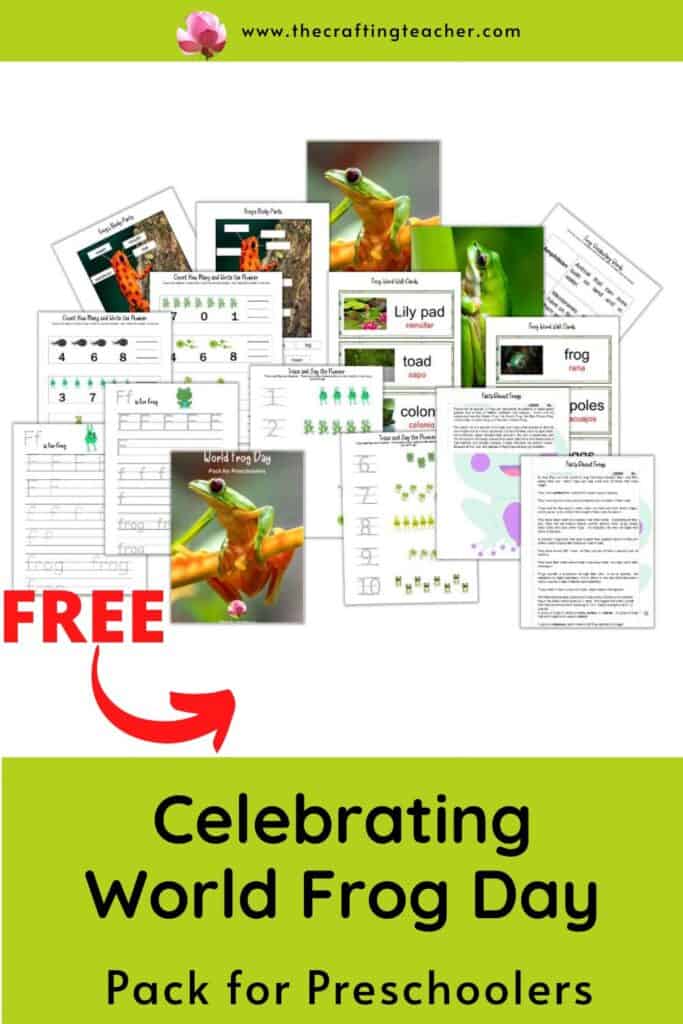
Frogs are fascinating creatures and by learning the facts about them, preschoolers can learn to appreciate and protect them, so they can continue playing their important role in our ecosystem.
Don’t forget to download your free Frogs pack. Just click on the button below, and type your information, for an immediate download.
I hope this information helps you promote in your children, family, and friends a deeper understanding and love for these amazing amphibious, and encourage in them the desire to become their advocates and protectors.
Be happy, safe, and creative. I wish you well.
Love,

P.D. Please let me know if any of these ideas work for you. My goal is to help you in any way.

